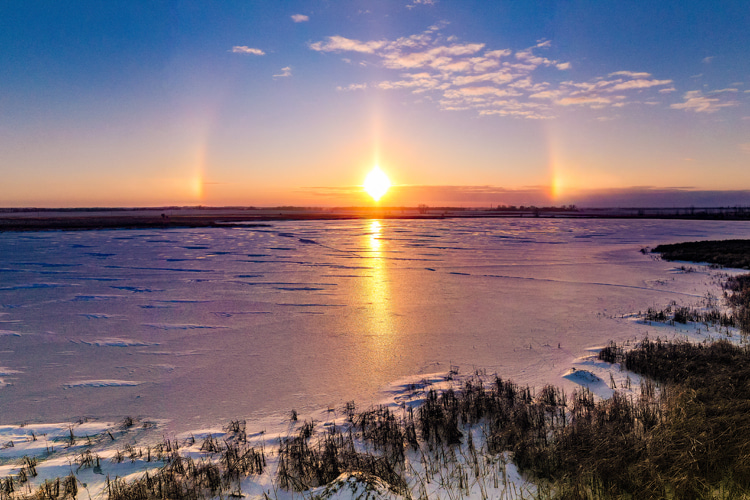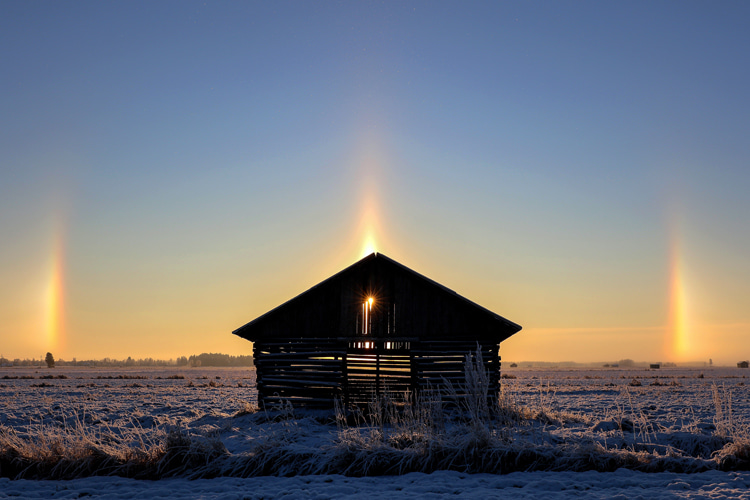
Sun Dogs
“two mock suns rose with the sun and followed it all through the day until sunset.”
– Aristotle, Meteorology
In our previous examination, we learned how it’s possible for snowfall to occur on cloudless days in the form of diamond dust. This precipitation transpires when water vapor turns into ice crystals near the ground.
What happens if these ice crystals occur higher in the sky? Though diamond dust is a rare spectacle, thanks to its dependence on extraordinarily frigid temperatures, chances are good you have experienced one version of optical phenomena associated with ice crystals: sun dogs.
Also known as mock suns or parhelia, sun dogs form when light interacts with ice crystals, usually hanging out in cirrus or cirrostratus clouds. They materialize as two blobs of light at the same altitude as the sun, usually each about a hand’s length away from our star when one’s arm is outstretched.

The ice crystals that form sun dogs function as prisms. The crystals are hexagonal and, when they drift downward horizontally, light enters one face and exits another. The points of hexagonal shapes meet at 60-degree angles, which means the light bends twice. This double refraction throws light sideways, away from the sun. The splotches they create are actually colored, as the individual parts of white light refract differently. The inner edges of the dogs are red, while the outer portions skew toward blue.
Why do we call these spots sun dogs? No definitive etymology persists. Some claim the moniker stems from Greek mythology, where Zeus walked his dogs across the firmaments, stationing them at the sides of the sun. In 1882’s Folk-etymology: A Dictionary of Verbal Corruptions Or Words Perverted in Form Or Meaning, by False Derivation Or Mistaken Analogy, Abram Palmer connects the term to dag, which connoted dew or mist. Still, others point to Norse mythology, where two wolves hunted the sun and moon.
Less ambiguous is parhelion. Ancient Greek’s word for the sun – helios – is crowned with the prefix para, meaning “beside.” Calling the phenomenon a mock sun is, perhaps, more intuitive to the modern speaker.

Partly due to the common nature of sun dogs – they can happen anywhere in any season – and partly thanks to the sun’s prominence in our lives, parhelia have featured eminently in human history.
Greek philosophers and poets, including Aristotle, Aratus, and Artemidorus, noted sun dogs in their writings. Cicero and Seneca are among the Roman equivalents to describe the happening.
Three suns appeared before the Battle of Mortimer’s Cross in 1461, during the Wars of the Roses in England. Supposedly, the man who became Edward IV used the sights in the sky to soothe his terrified troops, correlating the suns with the sons of the Duke of York. William Shakespeare later adapted this event and battle victory in King Henry VI, Part 3.
In 1629 and 1630, sun dogs appeared in Rome. These instances stunned philosopher Rene Descartes so deeply that he temporarily sidelined his famous metaphysical treatises in order to pursue their causes. He later published The World, which has a subtitle of Treatise on the Light.

Though we commonly know the intersection of ice crystals and light as mock suns, the same thing can and does occur with the moon!
A moon dog is rarer than its sunny counterpart, mostly because a bright moon is required. A parhelion’s analogous term is paraselene.

Sun dogs are spectacular optical treats, but they are far from the only ones we experience thanks to ice crystals. The conclusion of our theme week on sky ice will profile a few of the other dazzling sights of the heavens!
Further Reading and Exploration
Sundog formation – Atmospheric Optics
The Polar Vortex Is Causing Striking Solar Phenomena Called ‘Sundogs.’ Here’s What to Know – TIME
Sundogs – University of Illinois
Photos: Sun dogs create a show in the winter morning sky – Fox 11














Pingback: Light Pillars, 22° Halos, Tangent Arcs, Bottlinger’s rings, Parry Arcs, and Circumzenithal arcs – themountainsarecalling.earth